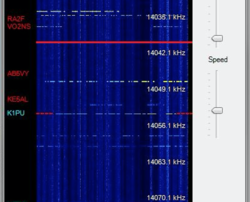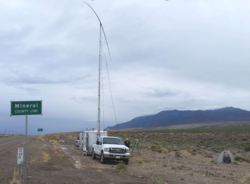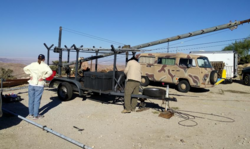 October 19, 2016 Editor: Paul Bourque, N1SFE | ||||||
IN THIS ISSUE
The best bet for some DX this weekend could be the UK/EI DX Contest, unless you're outfitted for 160 meters, and can participate in the warm-up to the Stew Perry Top Band Distance Contest, sometimes called the "Pre-Stew." As it's a weekend without an abundance of contests, you might want to "contest different." Try a new mode, put up a new antenna, or fix a piece of gear. Many hams will be traveling to multipliers this week, putting up antennas and fixing gear as they get ready for the CQ WW DX Phone contest on October 29-30. Hey Affiliated Club Competition Coordinators! Remember that for your club to be included in the ARRL Affiliated Club Competition, your information needs to be up to date on the Affiliated Club Competition website. You'll receive an authentication email after your information is updated. Note that there is also the ability to update club eligibility rosters before each contest. BUSTED QSOS Here is the correct link to the Feld Hell Club Spooky Sprint, which was held last weekend. Logs are due October 19. (Doug, KD4MOJ) Complete information for all contests follows the Conversation section October 20 October 21 October 22 October 26 October 27 October 28 October 29 November 2 If you participated in the Makrothen RTTY Contest last week, you'll want to send your logs to scottmcleman36@gmail.com, who has volunteered to collect them for scoring. The continued sponsorship of this contest is evolving, stay tuned for more information.
Steve, N2IC, submits: "The Waterfall Bandmap (WB) combines a live waterfall display with call sign and frequency spotting information. The beauty of the WB is that you do not need complex and potentially unreliable tools to interface the WB to your station. The WB tracks the frequency of your transceiver, and obtains DX spots directly from N1MM+. Unlike other waterfall implementations, the WB does not require virtual COM port splitters, VSPE, Omnirig, separate telnet connections, and the like. N1MM+ provides all the information that WB needs to work with your SDR receiver or sound card I/Q output to synchronize with your non-SDR station transceiver. WB works with any radio compatible with LP-PAN (such as the K3), Flex 6000 series, and the majority of SDR receivers, such as the Perseus, QS1R, or SDRplay. Best of all, Waterfall Bandmap is freeware. More information is available from the WaterfallBandmap Yahoo group. RSGB's Youth Committee is raising funds for YOTA (Youngsters On The Air) 2017 by providing supporter pins at various funding levels. One hundred percent of all donations will go to YOTA. Any time Heathkit gets mentioned, ears of hams of a certain age perk up. Electronic Design argues that manufacturer and aftermarket development kits have taken the place that Heathkit once occupied as the supplier of educational electronics platforms. (Ward, N0AX) In a bit of an interesting twist, a Kickstarter effort, goTenna, has built a mesh network hardware add-on to cellular phones so that they can be used in locations where there is no mobile operator infrastructure, for example remote DX locations, Burning Man, or inside a Faraday hangar. It uses Bluetooth to communicate with the cellphones, and it sounds like it has a bit of 'cognitive radio' capability. (Dennis, N6KI) The 41st IPARC (International Police Association Radio Club) contest is coming up on first weekend in November this year. The International Police Association is an international friendship and cooperation organization, with chapters in many parts of the world. The German section of the IPARC hosts the rules for the radio contest, and more information on IPARC is available on the German website. (Uwe, DJ6QQ)
If you operated in the Oceania DX Contest, logs are due by the end of October. Cabrillo phone logs go to ph@oceaniaDXcontest.com, CW logs to cw@oceaniaDXcontest.com, SWL logs to info@oceaniaDXcontest.com. Quagi The Quagi is an antenna for UHF or VHF that combines helpful characteristics of a Yagi with those of a cubical quad antenna. It generally consists of a quad-style loop for the reflector and driven elements, with Yagi-style director elements. An eight-element design was originally described by Wayne, N6NB, an April, 1977 issue of QST, followed up by an easy to build 15 element "Long Boom Quagi" in QST for February, 1978. The quad elements allowed for ease in construction and impedance matching.
Jim, K9YC, and Frank, W6JTI, usually "operate from very quiet places in the middle of nowhere" for contests like the 7th Area QSO Party. Here's a write up of their 2016 operation (PDF).
The results of the August UHF Contest are now online, including line scores for all log submissions, as well as club aggregate scores and top-ten lists. There will be an expanded results article for the contest in the not too distant future. (Wayne, N6NB) "Thanks to the efforts of N5KO and K5OT, complete sets of Sweepstakes records for both modes are now available at Sweepstakes page on the ARRL website as well as the Contest Records page. The records are available by category, by division, and by section. A complete list of winners by category, extending back to the first Sweepstakes in 1930, is also provided. For fans of statistics, the number of logs submitted each year and a cross-reference of call signs is also provided. This is some nice work! Is there a record in your location or favorite category that might be within reach this year?" (Bart, W9JJ) Submitting Logs Successfully Many contests are shortening the time between contest end and the log submission deadline. It pays to check the rules to make sure the log deadline hasn't changed since the last time you entered the contest. Also, more and more contests are publishing the list of submitted logs on their web site. Get in the habit of checking the 'received logs' pages to make absolutely sure your log was received. If you have a question about the rules, first, read the rules again. If your question is still unresolved, a polite email to the contest sponsor/director could clear things up in a jiffy. For example, here's a question I sent to Ed, W0YK, CQ WW RTTY Contest Director: "Hi Ed, in the RTTY contest a couple of weeks ago, there was a station in zone 8 sending zone 11 as the exchange. When asked for his 'CQ zone', he replied with 11; for the CQ WW RTTY Contest, what is the correct number for a station to log? What was sent, or what the correct zone would be?" Ed wrote back: "In this case, I'd go ahead and log '11' if you think that is what he will have in his log. The log checking will assign multiplier credit based on what the actual multiplier is, not what the station sent. But for cross-checking, it is safer for you to have in your log what he has in his log. If he was insisting on '54', then I'd log 8, because the robot and log checking will complain if the number is not in the range of 1-40." An email exchange with the contest director could be more insightful than a dozen email reflector messages for rules interpretation questions. If you're building your own capacitors out of various materials, you might want to measure the dielectric constant. KE9V tweeted this link to a hackaday article on doing just that. (KE9V via Twitter) Molybdenum disulfide was used recently by researchers to create a transistor with a gate size of one nanometer. The gate was formed out of a single carbon nanotube, and another unconventional material, zirconium dioxide, was used for the channel material. The size reduction reflects a 5 to 1 advantage over what is presumed to be a five nanometer lower limit for silicon transistors, but to be commercially successful, manufacturing process optimization will have to occur, according to an article in EE Times. We're beginning to see the use of Raspberry Pi computers for the foundation of a number of Amateur Radio projects. Design News recently published the history of the Raspberry Pi project. An RFI-free switching power supply is the goal of a recently triply-oversubscribed Kickstarter project. Who would have thought there would be such demand for a board level +/- 15 volt power supply module? One terabit per second data transmission via radio waves may be within reach, as researchers at Rice University are using pulses of RF at up to 10 GHz to achieve these data rates. (Dennis, N6KI) A counterpoint to exercise treadmill RFI horror stories? Here is a teardown of an RFI-free treadmill, made by Johnson Fitness. Highlights include separate toroids on the power and ground leads to the DC motor, a single point ground for DC, AC, and electronics grounds. (John, NU3E, via RFI Reflector) On the high end of network-enabled receiving hardware would be the EM100XT from Rohde & Schwarz. Besides being weatherproof with an IP67 rating, it also has a built-in GPS for timing and frequency accuracy. A direct audio output complements its built-in demodulation capabilities for modes including USB, LSB, AM, FM, CW. I/Q sample data is available via an Ethernet interface. Frequency coverage is from 9 kHz through 7.5 GHz. The EM100XT has the same functionality as the R&S EM100 unit. And So It Goes... Today's gear is more reliable, and has more features than ever. Today's radio manufacturers face new and increasing challenges when comparisons of miniaturization, portability, power consumption, connectivity, user interface, and industrial design sense are being made between their products and consumer electronics items such as cellular phones and tablet computers. For consumers of radio gear, "consumer electronics-esque" rapid innovation can have some downsides; our rigs may not stay current for as long as they used to, despite the ability to upgrade firmware. Manufacturers may End-of-Life a radio for various reasons related to cost or continuing availability of key components. And to repair or modify our equipment, we need to have continually newer tools, and newer skills. I was recently troubleshooting a transceiver that I originally purchased new in 2001. At the time, it had all of the performance of the brand's top of the line radio, without some user interface bells and whistles and second receiver. It was great as a main radio for a time, then slid into its role as a multiplier radio, then mostly for RTTY and VHF. Four years ago, I put it aside for repair after the transmit power diminished markedly and consistently during a contest, and found that the manufacturer no longer repaired this model. Last year I started to work on it, but discovered that some of the driver transistors were now made of unobtainium, and that to really get into the radio I'd need to upgrade my tools and techniques to handle surface mount parts. I ordered an inexpensive hot-air rework station, a head-mounted magnifier, and some replacement silicon, then reassembled and put the rig aside, as that's the best way I find to not lose anything. I've seen the sentiment that surface mount technology is hard, and bad for amateur radio gear. Perhaps the same was said of printed circuit technology in the 1950s as it supplanted point-to-point wiring. I would argue that the benefits of SMD clearly outweigh the drawbacks. Other projects and demands intervened, and I was unable to get back to the radio until last week. With the radio back on the bench last week, I found the service manual on line. An interest group dedicated to this radio model indicated that there were some parts of the driver chain known to have issues. Crowd sourced repair information on the Internet is an essential part of the new toolset, and the skills I needed were the ability to find the information, and then filter that for what was important and valid. Every repair begins with Google. I determined that the fault was likely in one or both of two successive driver stages. Using the hot air tool, I removed the transistor in the first driver stage, and then easily re-installed it with my eBay-sourced replacement. Turning on the power led to rapid dismay, as the claimed exact same-numbered replacement provided a dead short and burned up a surface mount resistor. After extensive examination of the circuit for other problems, I still found that two others transistors in the same snippet of tape and reel exhibited the same behavior, leading me to disbelieve that I'd received the correct parts. Avoiding mislabeled, substitute, or counterfeit parts is another modern challenge. So, I researched and found a very reputable source which had the parts in stock, ordered them, and reassembled the rig, and put it aside... That's all for this time. Remember to send contesting related stories, flea market pictures, book reviews, tips, techniques, press releases, errata, schematics, club information, pictures, stories, blog links, and blog links to contest-update@arrl.org 73, Brian N9ADG 20 Oct - 2 Nov 2016 An expanded, downloadable version of QST's Contest Corral in PDF format is available. Check the sponsor's Web site for information on operating time restrictions and other instructions. HF CONTESTS CWops Mini-CWT Test, Oct 19, 1300z to Oct 19, 1400z, Oct 19, 1900z to Oct 19, 2000z, Oct 20, 0300z to Oct 20, 0400z; CW; Bands: 160, 80, 40, 20, 15, 10m; Member: Name + Member No., non-Member: Name + (state/province/country); Logs due: October 22. VHF+ CONTESTS ARRL EME Contest, Oct 22, 0000z to Oct 23, 2359z; CW, Phone, Digital; Bands: 50-1296 MHz; Signal report; Logs due: December 21. October 20, 2016 October 21, 2016 October 22, 2016 October 23, 2016
October 25, 2016 October 29, 2016 October 30, 2016 October 31, 2016
ARRL Information Click here to advertise in this newsletter, space subject to availability. Your One-Stop Resource for Amateur Radio News and Information ARRL membership includes QST, Amateur Radio's most popular and informative journal, delivered to your mailbox each month. Subscribe to NCJ - the National Contest Journal. Published bimonthly, features articles by top contesters, letters, hints, statistics, scores, NA Sprint and QSO Parties. Subscribe to QEX - A Forum for Communications Experimenters. Published bimonthly, features technical articles, construction projects, columns and other items of interest to radio amateurs and communications professionals. Free of charge to ARRL members: Subscribe to The ARRL Letter (weekly digest of news and information), the ARES E-Letter (monthly public service and emergency communications news), Division and Section news -- and much more! ARRL offers a wide array of products to enhance your enjoyment of Amateur Radio. Visit the site often for new publications, specials and sales. Donate to the fund of your choice -- support programs not funded by member dues! Reprint permission can be obtained by sending email to permission@arrl.org with a description of the material and the reprint publication. ACKNOWLEDGEMENTS ARRL Contest Update wishes to acknowledge information from WA7BNM's Contest Calendar and SM3CER's Contest Calendar. | ||||||











